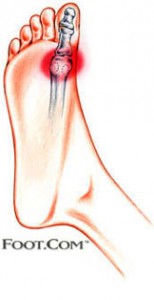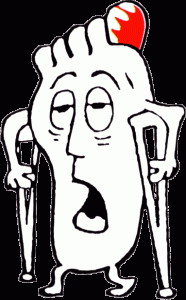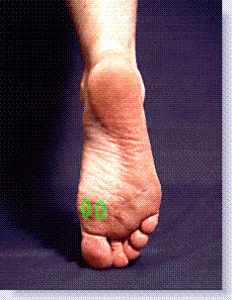Two words I’m loathe to utter: “I’m injured.”
It sounds so much better to say, “I’m trying to reach a peak training level, and something feels tweaked but I’m managing it.”
Both statements are true and related. I’m injured partly because I’m training harder, which made flaws in my form accentuate a weak spot and trigger pain. As my awesome guru podiatrist (more on him below) says, “You find your weak links when you’re pushing the envelope with higher mileage or higher speeds.”
Acknowledging the pain, getting a diagnosis, and altering my training to manage it reminded me of five lessons I’ve learned repeatedly while developing as a runner for the past fifteen-plus years:
1. Deal With It
“It’s not that bad.” “It’s just a hot spot with friction that ice and Aquaphor will take care of.” “I didn’t feel it this morning so it’s all better.” Those are some of the statements of denial that went through my head in the past three to four weeks as mild discomfort crept into the ball of my left foot. The soreness reappeared a few miles into most runs, and then it blossomed into radiating pain if I increased the pace past an easy conversational level.
 The ball of my left foot has bothered me for years, but usually only when I do a half-marathon or longer road race at my fastest pace. Afterward, a purplish-looking blister under the thick callous shows I’ve really stressed out the area. I hobble for a few days until it goes away—no biggie. But these last four weeks, it got worse instead of going away. Meanwhile, the Achilles tendon on the same foot started twinging acutely.
The ball of my left foot has bothered me for years, but usually only when I do a half-marathon or longer road race at my fastest pace. Afterward, a purplish-looking blister under the thick callous shows I’ve really stressed out the area. I hobble for a few days until it goes away—no biggie. But these last four weeks, it got worse instead of going away. Meanwhile, the Achilles tendon on the same foot started twinging acutely.
I was in denial, but my running log told the truth. Since I note my symptoms, I could verify that it hurt—not just bothered, but hurt—for about four weeks solid. I realized I needed to deal with it before it got worse and led to secondary injury from a pain-altered gait.
2. Beware of Self-Diagnosis
Researching online, I became pretty sure I had metatarsalgia, caused by pressure and friction on the metatarsal bones. I almost went out and bought an over-the-counter pad to stick in my shoe to relieve the pressure. But since the injury also involved my Achilles and I didn’t want to worsen the problem with forefoot padding that could further throw off alignment, I decided to make a pilgrimage to a podiatrist, Dr. David Hannaford, in San Rafael.
The flip side to “Beware of Self-Diagnosis” is, “Find a Good Doctor.” Is the doctor a runner? Will he or she remember your earlier problems from past visits and see how they relate to the current problem? Will he or she give you the time and tools (such as videotaping your stride) to analyze your form and pinpoint the cause of the pain?
You know you’re in good sports-med hands when you see a doctor who treats Olympians and ultrarunning legends, and he has medals and photos from the Western States Endurance Run, Marathon de Sables, Badwater, and the Death Ride hanging in the waiting room. Hannaford has treated and been endorsed by running icons such as Alberto Salazar, Ann Trason, and Jeff Galloway. He has run, biked, and hiked mountains all over the globe.
Getting in to see him isn’t easy. He holds office hours only a couple of days a week, and for about two months out of the year he and his wife, Debbie, travel to climb summits and explore remote jungles and forests. I caught him shortly before he was scheduled to depart on an excursion to Madagascar. His practice doesn’t take insurance, so a visit starts at 95 bucks out of pocket—a bargain, really.
He pulled my file, examined my feet, and then filmed me repeatedly running up and down a hallway.
By zooming in and playing it back in slow mo to pinpoint flaws in my form, he concluded I don’t have metatarsalgia. I have sesamoiditis. Says what? Inflammation of the sesamoids (two jellybean-shaped bones beneath the big-toe joint) and the tendons surrounding them. But why, and what should I do?
3. It’s the Biomechanics, Stupid
If only all bodies were as perfectly engineered and symmetrical as the way da Vinci drew them. In reality, most of us are off balance and very imperfect.
Books like Danny Dreyer’s ChiRunning give an in-depth explanation of biomechanics, which I won’t get into here, but just imagine your body as a bike with a wheel frame slightly bent or one pedal askew. Just as the frame needs straightening out for optimal riding, so too does our form for injury-free running.
For over a decade I’ve worked to line up my naturally turned-out legs and pronating feet, and to eliminate the bounciness caused by heal striking. For example, when I run down a street with a stripe in the pavement, I picture my foot landing parallel to the line. Little tricks like that can really help.
Hannaford, who first diagnosed my Achilles tendinitis several years ago, said my form is better now but still suffers from “propulsion pronation.” That means that after I push off, my foot falls in and puts too much stress on my big toe and ball of foot, while my calf curves too much and twists my Achilles. I need to reduce the force and friction by strengthening the arch muscles of my foot and pushing off more from the midpoint of the forefoot. This dormant problem flared up because I switched to more flat road running at a higher pace, at the same time when I switched from stiffer trail shoes to road shoes that don’t provide enough stability.
4. Stop Running Only If All Else Fails
Thankfully, I caught my injury early enough to dodge the phrase worse than “I’m injured,” which is: “Stop running.”
I’m wary of doctors who say “stop running” as if it’s a black-and-white matter. I had to stop running temporarily when I had shooting pain up my calf, and again when I broke my foot, but in my experience most running injuries can handle some degree of modified running in conjunction with treatment.
“Stop if it hurts” is not very useful advice because pain comes in degrees, and some level of discomfort is to be expected. The key is knowing whether to modify running by slowing down or changing terrain, or to stop all together. I find it’s helpful to have a “pain scale” whereby you judge discomfort on a scale of 1 – 10, with 1 being totally normal and 10 being so painful you couldn’t run even in an emergency. If my pain stays at a 3 or below, which I think of as “it’s talking to me,” then I keep running. If it graduates to a 4 – 6, then I walk. Anything 7 and above—where the pain become sharp rather than dull—I crosstrain if possible and don’t run until it’s back to 3 or below.
Hannaford laid out a series of treatment measures and said I could run through the injury with caution. He fixed me up with modified shoe inserts and told me to get a different type of shoe. He also told me to do exercises (see below) to accelerate the healing and prevent re-injury.
I entered his office with a healthy dose of skepticism about shoe inserts, aka orthotics, bolstered by a New York Times article last week headlined “Close Look at Orthotics Raises a Welter of Doubts.” I’ve heard too many stories of runners who spent a lot of money on custom orthotics that made matters worse by over-correcting or missing the injury. Hannaford acknowledged that making orthotics is as much an art as a science—which is why you should go to someone who really understands biomechanics and knows how to make them. He deftly affixed some padding to the arches of my shoe insert, which shifted my stance and stopped my left foot from falling in and pushing off only on the big toe area. The next day I ran pain free.
5. Injuries Are Your Body’s Way Of Telling You to Strengthen Your Weak Spots
Some people have to compensate for bad knees. Others have a pain in the ass. Often, specific stretches and strength training can alleviate the problem.
My ankles are my weak links. I religiously do exercises to strengthen them and restore their elasticity, such as heal raises and balancing one-legged on a balance ball. If you see me in line at the grocery, I’m probably standing on one leg and so I can twirl my other foot in circles to keep the ankle stretched and strong.
Given this new diagnosis, I’ll add foot exercises to the mix to strengthen the toes and arches—things like toe scrunches, “windshield wipers” (moving the foot side to side in a scooping motion), and picking up small objects like dice with my toes. If it’ll help me run pain free, I’ll do it. As someone once wisely advised, “Be as a serious about treating your injury as you are about training.”
Runner’s World online has a worthwhile series of prevention and treatment exercises for specific body areas, such as this one I’ll follow for my feet. Check it out, and please share your top lessons learned from running injuries in the comments below:




Wonderful posting, five great lessons to acknowledge in dealing with an injury. Number five – injuries remind you to strengthen your weaknesses – is especially key when increasing training to run long distances. I have a weak hip flexor. Sure as clockwork, if I don’t do my special stretches and strength training for just that weakness, boing!, I’m sure to develop a pain when my mileage gets above 50 miles a week. Prevention is much easier than rehabilitation.
Let me add one thought which has more to do with avoiding an injury. As you age or increase your speed or distances, you should give serious thought to being more active in your recovery efforts. I ritually use ice baths, a massage therapist, a medicine ball, stretches and a roller to recover from my harder days of training. It reduces injuries, allows me to train more frequently, and perhaps most importantly helps me sleep.
Lastly, I have gone to Dr. Hannaford for a similar injury years ago, and still start my running year by ordering his custom made insoles for three pairs of shoes. Best money I spend for health care.
Jeffery, thanks so much! I totally agree with what you say in the second paragraph (in fact I’ve got an ice-cold soda can rolling under my barefoot now as I type and was a good girl and spent quality time with the foam roller right after my run). I know what you say about your hip, too. I went through a phase where I had an extremely painful point near my hip, at the top of the IT band, that hurt so bad I couldn’t stand and get out of my car after driving home from a long run. It took a combination of core and glute exercises to get those muscles doing their job, plus IT band stretching, to heal it for good.
One thing I’ve learned with injuries like this is to alter the shoe. In this injury for instance, I’d cut out an area on the sole around the injury, so you can continue running while letting the irritated area heal. So there’s be a big hole in the sole where the bones are located. That takes some experimentation to see what provides support but at the same time no irritation.
If the injury spans several shoe cycles, you’d use the sole cutout that works for you as a “pattern” to cut the new shoe’s sole.
So don’t use a pad, but a cutout so that your bone doesn’t have something to bang down on when you run. If the sole is too thin, meaning you hit the base of the shoe with every stride, put in two soles (maybe using the sole from an old shoe), and do the cutout.
A pad’s a bad idea…you want the opposite. An indentation.
For me, #4 is the most important for people to understand. “Resting” will never help you figure out what is going on and how the situation can be alleviated – whatever is ailing you will just come back when you start running again. This is a great post!
I had so many blisters and sore spots on my feet and lower limbs that I really never enjoyed running. I am training now barefoot very carefully and I can see that I am gaining strength, flexibility and agility in my feet like never before. I am able to run for an extended period of time on asphalt and concrete and it’s working for me.
Gone are the shin splints and cramps in my quads and I am able to smile while running. What are your experiences in strengthening your feet and ankles going barefoot?
–Kai
Hi Kai,
Sorry to hear you suffered from blisters — that sounds like something you might be able to resolve by experimenting with different socks and shoes. But if going barefoot works for you, all the better. I encourage you to read my interview with Born to Run author Christopher McDougall, https://www.therunnerstrip.com/2011/03/born-to-run-author-christopher-mcdougall-interview/ which goes into my feelings on minimal shoes and barefoot running. I’m now running a fair amount in my New Balance Minimus, which are like Vibram 5 Fingers in the sole but w/o the separate pockets for toes, and it works for me on shorter runs. For longer paved runs and technical trail terrain, however, I still prefer my Asics, which have more protection. But running barefoot or in minimal shoes a few times a week is good for exercising your feet and improving your form, in my view.
Thanks, I am dealing with the same thing. This really helped me.
Good, I’m glad — good luck!
You have a very determined way of approaching healing, from “just dealing with it” to strengthening weak spots. Altogether, these tips and your tip to see a professional for a diagnosis could prove very useful.